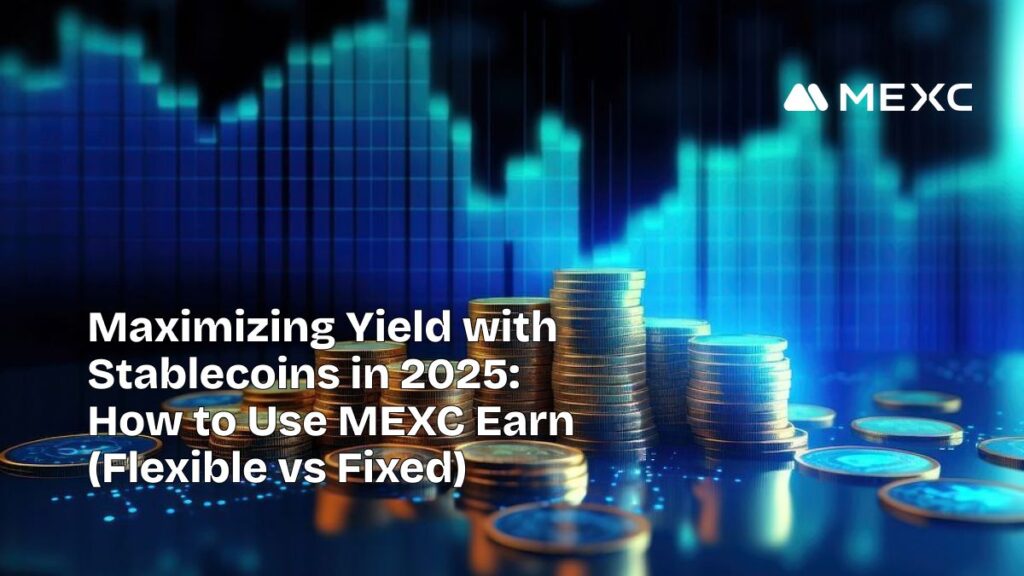
Stablecoins have evolved into much more than just tools for trading and payments. By 2025, they will be an essential component of yield generation strategies (on-chain with DeFi and off-chain with CeFi). As macro uncertainty, increasing interest rates, and volatility with other crypto assets continue, traders and investors have begun shifting idle stablecoins into income generations with reasonable risk.
If you’re thinking about where to park your USDT, USDC, or other stablecoins so the yield could do well without excessive risk, you will want to read this. This will cover:
- What different kinds of yield strategies out there (flexible vs fixed, DeFi vs CeFi)
- How MEXC Earn works, and where it sits in these strategies
- Which stablecoin yield opportunities look best in 2025
- What are the key risks, and how do we choose what fits your style
1.Getting Started: Flexible Vs Fixed Yield
Before you decide where you will lock your stablecoins, you must first understand two fundamental models:
Flexible (or flexible-savings) — These are savings products, where you deposit your stablecoins, earn yield, and can withdraw (or move) your stablecoins whenever you desire. Because liquidity is present, the APY is typically lower. The flexible model, however, gives you control and flexibility, which can be critical to have in volatile markets, or if you think you might need to use those funds.
Fixed (or locked-savings) — You take the decision to lock away your funds for a determined amount of time (30 days, 60 days, 90 days, or convertible to either stablecoins or be used for other crypto-based investment purposes–conceptually known as”opportunity cost”). In exchange for eliminating liquidity, you receive a higher APY. In the event APY (according to market forces) is rising, locking in can be very useful, but you lose flexibility and need to accept feelings of risk based on price fluctuations of markets of a domestic origin (or locked positions through other virtual hypothecation transactions).
2.MEXC Earn and Savings: All That it Is

MEXC offers products to users who can benefit from an “Earn”/”Savings” suite of tools, and the availability of both flexibility & fixed form payments that will provide users yield opportunity on their stablecoins.
- MEXC Saving includes Flexible and Locked Savings. Flexible Savings means you can withdraw anytime; while locked or fixed savings may have higher yields for asking you to lock in for a specific time period.
- MEXC Earn is an area that includes savings (like) and also staking (like) products. You can view rewards, with options of terms, often with options to compound or reinvest your rewards.
For example, if you had USDT, MEXC might offer a Flexible Savings rate of X% (lower) and a Locked Savings rate of Y% (higher). The actual offered rate depends of course on the market from a supply and demand perspective, but there is also the popularity of the product to take into account – there might be a limit, that gives you more yield for smaller amounts.
3.Stablecoin Yield Market: CeFi vs DeFi in 2025
Knowing where the rates are across platforms it is helpful to look to decide what is competitive. Here’s a snapshot of what recent research indicates:
- CeFi platforms are offering a yield on stablecoins (such as USDT, USDC) generally in the range of 4-14% (APY), particularly on fixed-term or locked products.
- DeFi protocols (lending, liquidity pools, etc) typically have an equivalent yield but they are more variable, depend on utilization, and have risk (smart contract, collateral risk, etc.) Some DeFi yield may be boosted by incentives or token rewards.
- Platforms like Eco, TransFi, etc. are comparing stablecoin yields across CeFi and DeFi, showing that well-established CeFi options are attractive for many because of user interface, customer support, and lower operational hassle.
4.Top Yield Opportunities on Stablecoins via MEXC
Here are specific ways you can use MEXC Earn or Savings to earn stablecoin yields in 2025, including when to pick flexible vs fixed:
| Use-Case | Best Option | Why Choose It |
| You want safety + liquidity (you might need access) | Flexible Savings with USDT / USDC on MEXC | Offers daily or periodic interest, ability to withdraw anytime. Good for holding your stash while waiting for entry points or during volatility. |
| You have stablecoins you can leave idle for a short term | Locked / Fixed Savings or MEXC Earn locked plans | You get significantly higher yield by committing for 30-90 days or more. If stablecoin demand is high, these locked rates rise. |
| You want the highest yield and are comfortable with complexity | Explore DeFi lending & liquidity pools (outside or inside MEXC Earn when available) | Some yields are boosted by rewards. But risk (liquidity, smart contract) is higher. |
| You want compounding and maximizing return | Reinvest rewards (if product allows), or use Earn products that auto-compound | Over time, even small differences in rate add up when compounded. |
MEXC is well positioned here because it gives you both flexible and fixed options in one platform. That saves you from managing multiple wallets or platforms and helps you see whether locking yield is worth it given the rates on offer.
5.Sample Stablecoin Yield Comparison (Estimations for 2025)
The following reflects some illustrative yield estimations you may see in mid-2025 (examples not guarantees):
- Flexible Savings (USDT/USDC, MEXC): ~ 4-8% APY
- Fixed Savings (30-90 days): ~ 8-12% APY
- CeFi lending platforms (USDT/USDC, fixed): ~ 6-14% APY
- DeFi protocols (lending / LP pools, with rewards): ~ 5-12% (higher occasionally, if strong incentives) +1
6.Risks & What to Pay Attention To
Yield isn’t free. Below are the trade-offs you will need to think about when you invest, especially for stablecoins or locked savings:
- Lockup risk: If you fix it for 60 or 90 days, you can’t move those funds quickly if better rates come along (or if you want to exit)
- Counterparty / platform risk: On MEXC or any CeFi service you assume a risk for solvency, security and operational integrity. In DeFi, you assume smart contract bugs, protocol risk and impermanent loss could diminish returns.
- Risks with Stablecoins: Even stablecoins have risks (e.g., peg stability, issuer reserves, regulatory risks). Before locking or staking into stablecoins, make sure you choose one that has good backing and audits that you can see.
- Opportunity cost: If you lock into a fixed plan and other rates go up, you miss out on better yields elsewhere.
- Compounding frequency and fees: Some products pay interest or rewards daily or weekly, while others pay less often. Withdrawal fees or un-staking fees cut into your returns.
7.Tips & Tools for Earning The Most from MEXC
Use the following practical strategies to help you maximize fixed and earn best from stablecoin yield products using MEXC Earn and tools like it:
- Track flexible and fixed rates continuously: there are often locked yields that are high (or spike) on the fixed side due to demand and slightly lower rates on flexibles that are comparable to locked rates.
- Start small on fixed savings until you feel comfortable on the fixed lock up periods and un-staking rules.
- If a product allows compounding, take advantage: some products allow you to reinvest the interest/rewards, rather than having it sit in your wallet. Compounding just increases growth.
- Stay Frontloaded: Don’t put all your stablecoins into one product or protocol. Mix some flex, some fixed, maybe even some on-chain (DeFi) if you are comfortable with it.
- Watch the macro trends (stablecoin demand, interest rate environments, regulation). For example, the increase in macro rates typically causes CeFi yields to increase. Regulatory changes could also change the behavior of stablecoin issuers.
- Utilize the MEXC features: utilize the MEXC Savings / Earn dashboard to compare offers and lock period options, and also to check yield history. Promotions to boost APY can add significant yield during times of low macro rates.
8.In Conclusion
Stablecoins are quickly emerging as one of the most significant building blocks for passive income in the crypto space, especially as volatility and risk in other assets increase. Whether looking at fixed or flexible opportunities, or the difference between CeFi and DeFi models, there are now very meaningful opportunities for traders and holders to create yield this year!
MEXC Earn and Savings offer a great opportunity to benefit from: you get liquidity and independence (using flexible plans), higher rates (using fixed plans), and an established platform with wide stablecoin support.
If you are using stablecoins, don’t let them sit idle – use MEXC’s options, compare between what’s possible, learn where the lock-ups are, and use what fits your risk profile. Over time, even small differences in yield accumulate.
Disclaimer: This content is for educational and reference purposes only and does not constitute any investment advice. Digital asset investments carry high risk. Please evaluate carefully and assume full responsibility for your own decisions.
Join MEXC and Get up to $10,000 Bonus!
Sign Up


